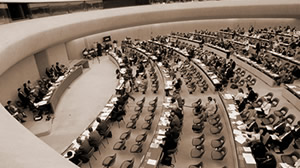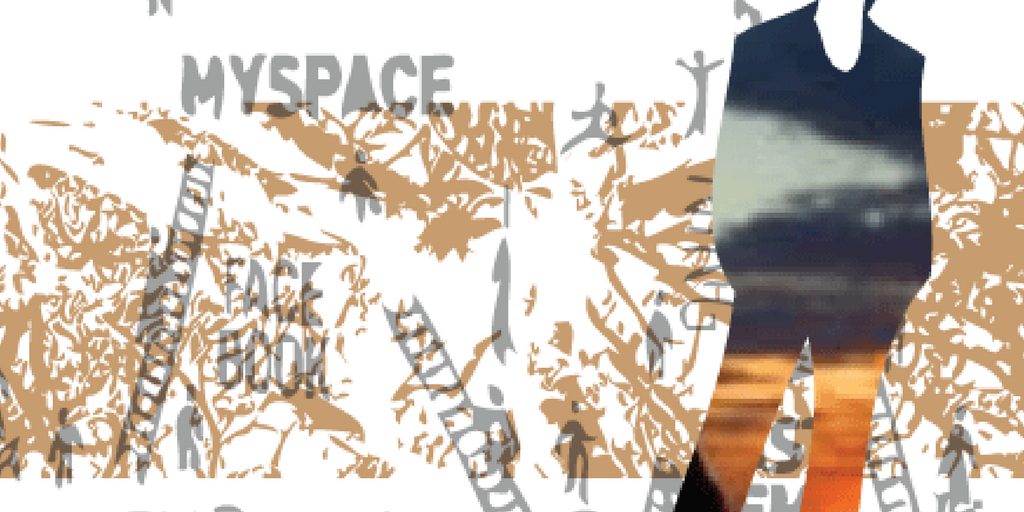
Special Rapporteur: Listen to Independent Voices
March 25, 2011As Strong as Our Signal: An Evolving Novelty
March 25, 2011The Nation State and migration
For as long as people have looked for new opportunities, resources and biotopes, migration has taken place. It is only in modern times that the displacement of people has occurred under the constraints of nation states, regulations, and rules of legitimization.[1] In the modern world, system boundaries — national borders — are seen as regulating the process of demographic developments and migration flows. The era of globalization, characterized by what Manuel Castells[2] (1996) calls the rise of the network society, has created a foundation for the emergence of newly constructed forms of local and/or transnational cultural ‘imagined communities’.[3] One of the impacts of recent globalization is the formation of new offline and online transnational connections among migrants worldwide. The formation of these networked communities is often linked to concepts such as home(land) and identity.
Diaspora as transnational network
Diaspora, in the view of James Clifford,
involves dwelling, maintaining communities, having collective homes away from home (and in this it is different from exile, with its frequently individualistic focus)…Diasporist discourses reflect the sense of being part of an ongoing transnational network that includes the homeland, not as something simply left behind, but as a place of attachment in a contrapuntal modernity.
The important aspect of Clifford’s definition of diaspora, which differs from exile, is the way in which home and return are understood. Unlike exile, diasporic understanding of homeland signifies not a place of return but a source of shifting and ambivalent attachment. In this sense, the past serves as a common base for diverse communities to connect.[5]
This approach to diasporic positioning contrasts with the traditional definition of diaspora, in which a construction of collective suffering and the urge to return to a national homeland remain central.[6]
Deterritorialized and ‘reterritorialized’
The approach to the diasporic condition taken in this article is not defined as (up)rootedness in one or another place (either the country of origin or the new country), but as a state in which different places overlap .[7] Many studies show that notions like ‘culture’, ‘homeland’ and ‘origin’ are more complex than can be described by a link to a certain territory or root.[8] These concepts have become gradually deterritorialized and ‘reterritorialized’ in a transnational way. [9] Within this framework a shift has taken place in defining identity. This shift focuses on the processes involved in constructing, imagining, and changing identity amid a variety of cultures and discourses that are articulated and negotiated in a transnational context. In this way, diasporic positioning is not rooted but it is ‘rhizomic’, like the roots of crabgrass, which intertwine in a complex way under the earth and are not easily or even directly uprooted. [10]
Diasporas as rhizomic networks
The rhizomatic network describes decentralized, distributed patterns of human organizations. That is not to say that there are no rules and restrictions within these rhizomatic networks, but that the authority and control over migration, transnationalism and diaspora become more distributed and ‘networked’.
Networks are not neutral phenomena. Recent studies offer useful insights into the (hidden) power in network structures.[11] Network analysis builds upon the idea of social capital, which explains how people do better (that is, are more powerful) because they are somehow better connected with other people. Social capital is the sum of resources, actual or virtual, that increases if an individual becomes connected to networks of more or less institutionalized (durable) relationships. [12] In this way, social capital is linked to one’s identity, not so much in terms of one’s roots but in terms of one’s rhizomatic, networked connections.
The virtual dimension of transnational networks
ICT, and especially the Internet, has created a new dimension in the ways that social realities are being constructed and negotiated. Recent studies have shown that members of immigrant/diaspora networks, such as the Iranian one, use the Internet not only to form communities inside nations but also to make cross-border, transnational connections. The virtual dimension of networks is an important factor when considering the overlap of spaces within transnational networks, although the importance of these spaces could differ based on the positioning of various groups within the diaspora. In spite of this diversity, technologies such as the Internet and the World Wide Web, multimedia communication, and cyberspace modify the nature of interpersonal relations and communication.[13]
Virtual ties make creative transmission of information possible
The importance of network ties for economic transactions and knowledge exchange is well known. Network ties embed the economic action in economic and social structures. The Internet makes new forms of embeddedness possible by means of virtual embedded ties — linkages that are initiated and maintained through electronic technologies and that provide alternative solutions to problems of (knowledge) exchange. Virtual ties make creative transmission of information possible and (can) include privately and publicly known information.
Virtual (cyberspace) and offline behavior
The virtual, however, is by no means a concept without problems. The assumption that technologies can easily be used to link micro to macro networks in any situation is somewhat naive; what is important is to study how virtual (cyberspace) is interconnected with offline behavior, power and identity of the members of a given network.
The end of the nation state
The rhizome network metaphor used above refers not only to spatial and virtual elements but, and perhaps more importantly, to the way in which power is divided. We started this article with the concept of the nation state. Arguably, the nation state no longer has absolute (Hobbesian) power over its citizens. In this respect we observe a paradoxical process in which the power of the nation state is waning in the globalization era, yet at the same time the state is making an intentional effort to enforce intensified hierarchies and hierarchical organizations, for instance by developing transnational policies and initiating migration and transnationalism. The transnational networks of the diasporic members of the nation state, however, often act at odds with national rules and restrictions.
The diasporic condition is not bound by national rules
The diasporic condition is not bound by national rules and regulations, but it is certainly influenced by nation states, be it through national restrictions and/or nationally based patterns of communication and positioning. In this sense, the diasporic condition is about creating chains of networks worldwide, based upon a constructed sense of (cultural) sameness in background.
The meanings attributed to this ‘common’ identity, however, are anything but static and homogeneous. Rather, they are diverse, heterogeneous, multi-layered and dynamic, because of their contextual and situational characters. It is precisely the multi-layered and dynamic character of diasporic networks that offers the possibility to enrich individual members of these networks in a variety of ways.
Diaspora effect
Because a network is never complete or absolutely stable — there is a variation in the way people are related to each other — there can be (groups of) people within a network that are unaware of one another. Brokers, or network entrepreneurs, are very important in building bridges from one place in the network to another. In what they call the ‘diaspora effect’, Kilduff and Corley show that in many ways diasporas have an influence on the nations they have left behind. This effect is not only visible when diaspora groups keep in touch with friends and relatives who remain, but when they create new networks through which they can communicate their new (cultural) competencies as well. They act, intentionally or unintentionally, as brokers within transnational networks.
Because a network is never complete or absolutely stable — there is a variation in the way people are related to each other — there can be (groups of) people within a network that are unaware of one another. Brokers, or network entrepreneurs, are very important in building bridges from one place in the network to another. In what they call the ‘diaspora effect’, Kilduff and Corley show that in many ways diasporas have an influence on the nations they have left behind. This effect is not only visible when diaspora groups keep in touch with friends and relatives who remain, but when they create new networks through which they can communicate their new (cultural) competencies as well. They act, intentionally or unintentionally, as brokers within transnational networks.
References
[1] Wallerstein, I. (1976) The Modern World-System. New York: Academic.
[2] Castells, M. (1996) The Rise of the Network Society. Vol I. http://bit.ly/httWS0
[3] Anderson, B. (1983) Imagined Communities: Reflections on the Origins and Spread of Nationalism. London: Verso.
[4] Clifford, J. (1994) ‘Diasporas’, Cultural Anthropology 9(3): 302–38.
[5] see also Naficy, H. (1993) The Making of Exile Cultures: Iranian Television in Los Angeles. Minneapolis, MN: University of Minnesota Press: 17
[6] Cohen, R. (1997) ‘Diasporas, the Nation-State, and Globalization’, in Wang Gungwu (ed.)
[7] Appadurai, A. (1997) Modernity at Large: Cultural Dimensions of Globalization. Minneapolis, MN: University of Minnesota Press.Gilroy, P. (1997) ‘Diaspora and the Detours of Identity’, in K. Woodward (ed.) Identity and Difference, pp. 299–346. London: Sage.;Hall, S. (1990) ‘Cultural Identity and Diaspora’, in J. Rutherford (ed.) Identity: Community, Culture, Difference, pp. 222–37. London: Lawrence and Wishart ;Hall, S. (1992) ‘The Question of Cultural Identity’, in S. Hall, D. Held and T. McGrew (eds) Modernity and its Futures, pp. 273–316. Cambridge: Polity Press;Malkki, L. (1995) ‘Refugees and Exile: From “Refugee Studies” to the National Order of Things’, Annual Reviews Anthropology 24: 495–523.
[8] Appadurai, A. (1988) ‘Putting Hierarchy in Its Place’, Cultural Anthropology 3(1): 36–49; Malkki, L. (1992) ‘National Geographic: The Rooting of Peoples and the Territorialization of National Identity among Scholars and Refugees’, Cultural Anthropology 7 (1): 24–44.
[9] Ghorashi, H. (2004) ‘How Dual is Transnational Identity? A Debate on Duality of Transnational Immigrant Organizations’, Culture & Organization 10(4): 329–40.
[10] Deleuze G. and F. Guattari (1987) A Thousand Plateaus. Capitalism and Schizophrenia. Minneapolis, MN: University of Minnesota Press : 21, 2)
[11] Cross, R. and A. Parker (2004) The Hidden Power of Social Networks. Understanding How Work Really Gets Done in Organizations. Boston, MA: Harvard University Press.
[12] Bourdieu, P. (1990) The Logic of Practice. Stanford, CA: Stanford University Press; Burt, R.S. (2005) Brokerage and Closure. An Introduction to Social Capital. Oxford: Oxford University Press; Ibarra, H., M. Kilduff and W. Tsai (2005) ‘Zooming In and Out: Connecting Individuals and Collectivities at the Frontiers of Organizational Network Research’, Organization Science 16(4): 359–71; Putnam, R.D. (1993) Making Democracy Work. Princeton, NJ: Princeton University Press.
[13] Abbate, J. (1999) Inventing the Internet. Cambridge, MA: MIT Press; DiMaggio, P., E. Hargittai, W.R. Neuman and J.P. Robinson (2001) ‘Social Implications of the Internet’, Annual Review of Sociology 27: 307–36.
[14] Kilduff, M. and K.G. Corley (1999) ‘The Diaspora Effect: The Influence of Exiles on Their Cultures of Origin’, M@n@gement 2(1): 1–12.
This piece is adapted from a larger article, The ‘Iranian Diaspora’ and the New Media: From Political Action to Humanitarian Help, originally published in the journal Development and Change, 40(4): 667-691.





